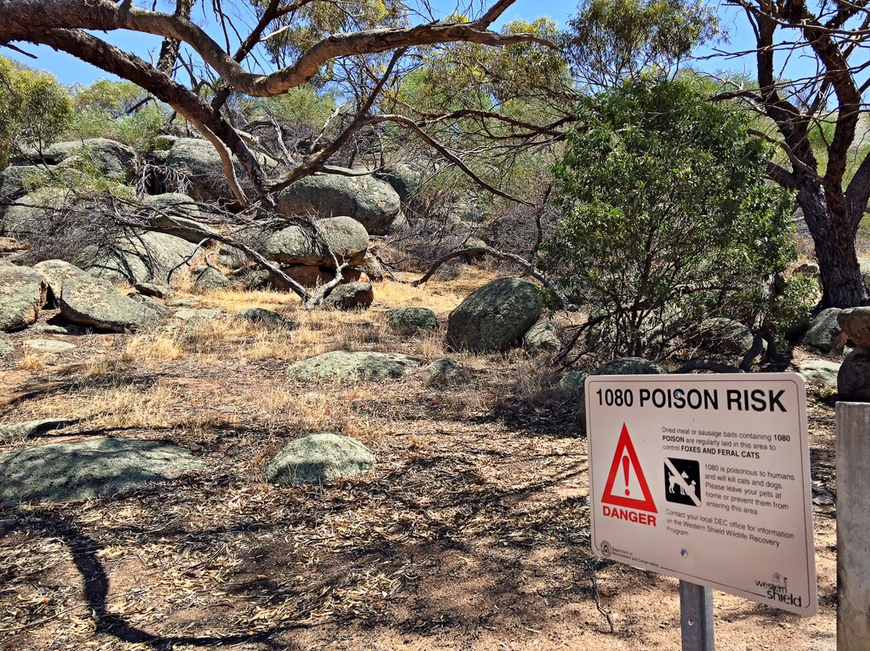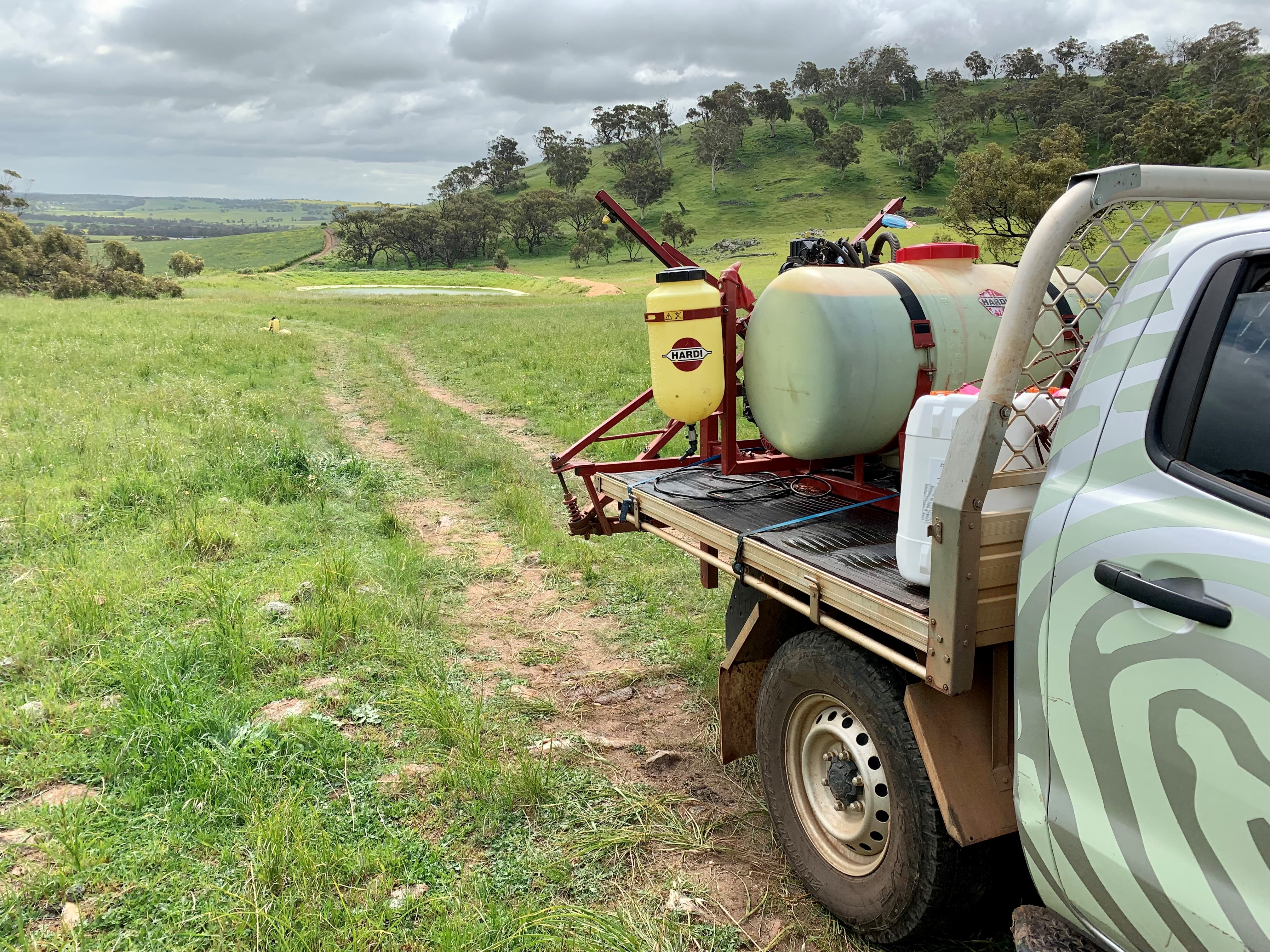As the weather warms up, the Wheatbelt bush, and newly planted or naturally germinated seedlings are springing to life. At the same time the foxes of the Wheatbelt are having cubs, weeds are trying to outcompete new seedlings and the rabbits are keeping on breeding, dispersing across the landscape, eating newly planted seedlings and supporting higher numbers of feral cats and foxes. To protect the bushland on your property and the many birds and animals that call it home, spring is an important time of year for fox, cat, rabbit and weed control. If you are undertaking vertebrate pest control, it’s important to manage all species at the same time. If you undertake rabbit control without also controlling foxes and cats, these predators will prey switch and increase the numbers of native species and domestic animals that they consume. While if you control foxes and cats without also controlling rabbits you will see an increase in your rabbit numbers. Are foxes, cats and rabbits having an impact on your bottom line? Support funding of up to $2,500 is available. You can apply quickly and safely online here.

1080 baiting
To use 1080 bait you need to be certified and have a valid permit from the Department of Primary Industries and Regional Development.
Fox Baiting
Fox control in early spring will have the greatest impact on your fox populations, as you can prevent the new season’s cubs from reaching maturity.
1080 baiting for foxes
- Your property must be greater than 10 hectares (25 acres)
- Laying baits at roughly 500m intervals will help to ensure you adequately cover the property, without wasting bait.
- Laying too many baits close together can result in foxes collecting several and burying them in a cache
- We recommend marking where you lay your baits (mark them with flagging tape) so you know whether they are being taken
- To reduce the chances of non-target species taking baits it is recommended you:
- Bury baits. Dig a small hole using a spade or mattock, insert spade into the soil and lever back about 50-100mm, drop in the bait and lever the hole shut.
- Tether. Tether baits to a fence post to prevent non-target species (e.g. birds) taking the baits. This will also prevent birds from moving the baits around.
- You should replace all baits each week or two, or after any rains, as the 1080 in the bait will start to breakdown if left in the environment, which can result in sub-lethal baits in the environment
- At the end of each baiting period, all remaining baits should be collected and disposed of, as per the directions on the product label
Cage trapping for cats and foxes
Cage trapping is particularly effective at controlling feral cats and young foxes.
It is important to follow strict animal welfare protocols when undertaking cage trapping, including:
- Setting the trap in the late afternoon.
- Checking and closing the trap first thing the following morning.
- Keeping the trap closed throughout the day – this will not only reduce stress and harm to target animals, but also significantly reduce the chances of catching non-target species - including common non-target captures like crows and reptiles, which are most active during the day.
- Placing the trap in a sheltered location (i.e., under a bush).
- Wrapping the trap in a hessian cloth to protect any trapped animal from the weather and further reduce the capture of non-target species – wrapping also increases chances of target species capture.
There is a real art to cage trapping, and we have many tips and tricks for you to try here
Rabbit Control
There are several ways to control rabbits, however spring is not the most effective time of year for some control techniques. To control rabbits in spring we recommend:
- Fumigation
- Instructional video here
- Most effective if followed up with warren destruction
- 1080 baiting
- Due to the excessive amount of delicious green grass around, 1080 baiting isn’t the most effective in spring, however if you use ready to lay oats in rabbit bait stations, it can still be effective, if a little slower working, in spring.
- To have any luck with 1080 baiting in spring it is vital to use the ‘ready to lay’ oats, as these don’t require rabbits to eat a large number of oats in a short amount of time
- Rabbit bait stations help to protect the bait from rain, which quickly washes 1080 off rabbit oats. Bait stations such as these here or a home-made station
- Calicivirus release
- Autumn, before rabbits start breeding and while the flies and other insects are out, is the best time of year to release the virus, as the insects help to spread the virus, and lactating females can pass virus immunity onto their young
- Spring is the second-best time of year to release the virus – preferably later in the season, when females have stopped feeding their young, and after the insects have returned en masse.
- You will need to complete online training through DPIRD to release calicivirus. You can do this here.
- Harbour reduction/destruction:
- Remove rubbish piles within bushland
- Survey your property for rabbit warrens
- For any warrens showing activity it’s important to fumigate, conduct 1080 baiting or release the calicivirus a good 3-4 weeks prior to destroying a warren, as any rabbits remaining in a destroyed warren can dig out and restart the warren
- For accessible warrens in the paddock you can rip the warren:
- Ripping should begin 2m out from the furthest entrance to ensure you get the full warren
- Ripping should be done in a grid pattern, with rip lines 0.5m apart and tines 70-90cm deep
- Monitor the warren for several weeks after ripping to check for activity and potential reopening of the warren
- For inaccessible warrens, for example within bushland:
- Find all warren entrances (whether active or not)
- Dig every entrance down about 50-60cm and block it off with large rocks, filling the soil back into the hole, around the rocks
- Return to the warren to monitor activity for several weeks, to ensure you can stop the warren from being reopened
- Shooting
- When combined with other control methods, shooting is an effective control option, however in spring it becomes increasingly difficult as the weeds as the animals can easily hide in amongst weeds and crops
Weed control within revegetation sites, or within native bushland
Weed control is vital for at least the first 2 years after revegetation, to give seedlings the best chance to establish. Weeding within remnant vegetation can also help regeneration of the species found within the remnant.
Methods for controlling weeds in revegetation areas:
- Maintain 1 m weed free buffer surrounding each seedling
- Manual weed control
- For smaller sites you may find manual weed control is an option
- Hand pulling, or using a hoe may be effective
- Try to avoid disturbing the roots of any planted seedlings
- Over-spraying
- Depending on the diversity of your planting, it may be possibly to overspray your planting using a selective herbicide – such as Fusilade, so long as your revegetation doesn’t include any native grasses
- Take care to ensure your sprayer is correctly calibrated and only use the rates identified on the product label
- Shielded or directed spraying
- Broad-spectrum herbicides – such as glyphosate – may be used around your seedlings provided you are very careful to avoid spray drift and use an effective shield over the end of the spray nozzle (google herbicide spray shield)
- For high growth/absentee landholder areas you may consider staked flagging tape around seedlings to make locating them much easier for weed management
These projects are supported by funding from the Australian Government's National Landcare Program.


